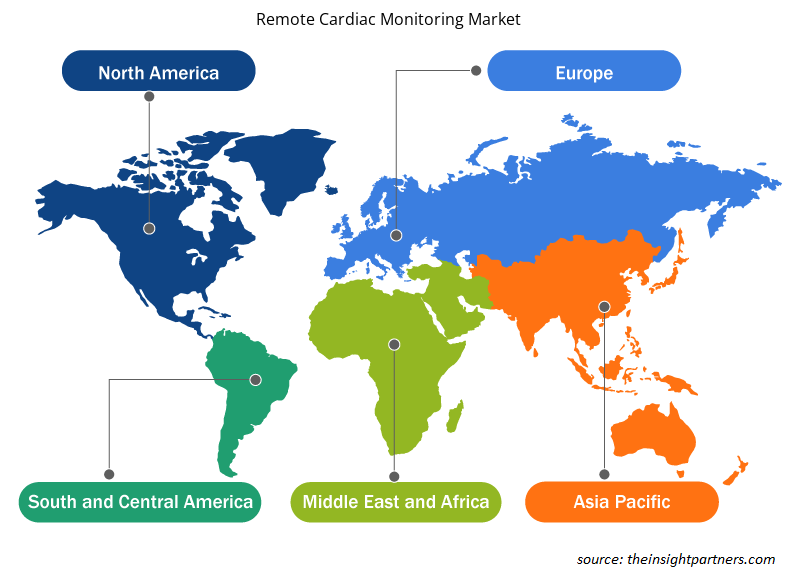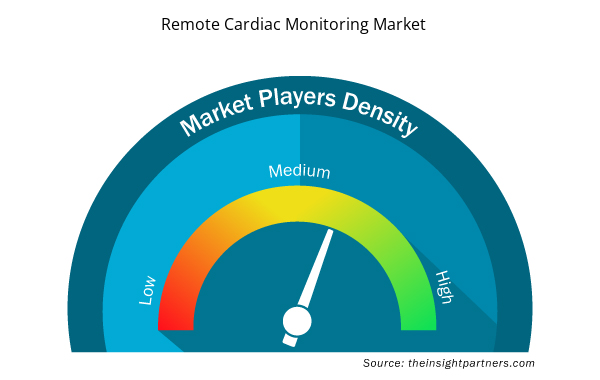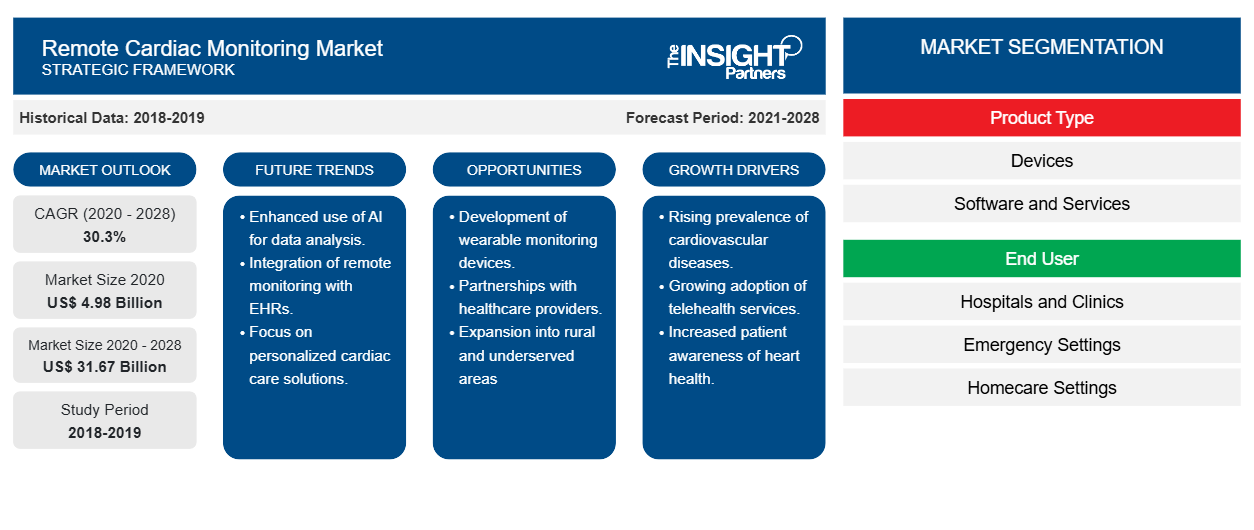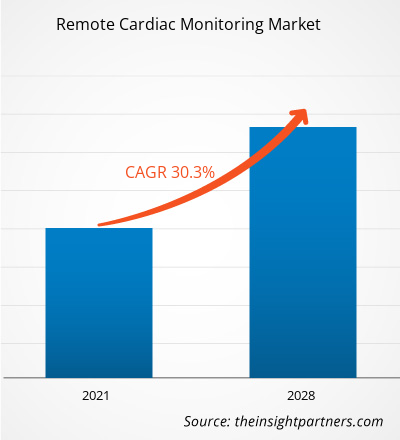Se proyecta que el mercado de monitoreo cardíaco remoto alcance los US$ 31.671,69 millones para 2028 desde los US$ 4.976,40 millones en 2021; se estima que crecerá a una CAGR del 30,3% entre 2021 y 2028.
Los dispositivos de monitorización cardíaca a distancia permiten una monitorización continua de las actividades eléctricas del corazón fuera de los hospitales. También permiten la monitorización electrocardiográfica (ECG) en el hogar de pacientes con sospecha de arritmias cardíacas o en riesgo de desarrollar arritmias. La monitorización también se puede realizar cuando los pacientes están inmersos en sus actividades diarias. Por tanto, uno de los beneficios más importantes de la monitorización cardíaca a distancia con dispositivos es que disminuye la necesidad de visitas médicas de rutina. Dispositivos como marcapasos y desfibriladores cardioversores implantables se implantan en el corazón de los pacientes mediante procedimientos mínimamente invasivos. Un transmisor que funciona en sincronía con el dispositivo se encarga de la transmisión de datos. Factores como el aumento de la incidencia de enfermedades cardiovasculares (ECV) y los continuos avances en el enfoque de la telemedicina impulsan el crecimiento del mercado de la monitorización cardíaca a distancia . Sin embargo, las preocupaciones sobre la privacidad de los datos obstaculizan el crecimiento del mercado.
Personalice este informe según sus necesidades
Obtendrá personalización en cualquier informe, sin cargo, incluidas partes de este informe o análisis a nivel de país, paquete de datos de Excel, así como también grandes ofertas y descuentos para empresas emergentes y universidades.
- Obtenga las principales tendencias clave del mercado de este informe.Esta muestra GRATUITA incluirá análisis de datos, desde tendencias del mercado hasta estimaciones y pronósticos.
Perspectivas del mercado
Aumento de la incidencia de enfermedades cardiovasculares
La monitorización remota de pacientes (RPM) permite a los pacientes gestionar mejor su salud al aumentar su participación en su atención médica. La Asociación Estadounidense del Corazón apoya iniciativas para incentivar el diseño y el uso de tecnologías de monitorización remota de pacientes basadas en evidencia. Según la Organización Mundial de la Salud (OMS), las enfermedades cardiovasculares (ECV) se encuentran entre las principales causas de muerte en todo el mundo, y aproximadamente 30 millones de personas sufren un accidente cerebrovascular cada año. Según la Asociación Estadounidense del Corazón, casi la mitad de todos los adultos en los EE. UU. tienen un tipo de ECV. Además, se proyecta que más de 130 millones de personas, es decir, el 45,1% de la población de EE. UU., tendrán un tipo de ECV para 2035. Según informes de la Sociedad Europea de Cardiología, las ECV causan 3,9 millones de muertes en Europa y más de 1,8 millones de muertes en la Unión Europea (UE). Además, representan el 45% de todas las muertes en Europa y el 37% del total de muertes en la UE. En los países de Asia y el Pacífico, la mortalidad por ECV oscila entre menos del 20% en países como Tailandia, Filipinas e Indonesia y entre el 20% y el 30% en las zonas urbanas de China, Hong Kong, Japón, Corea y Malasia. Además, Nueva Zelanda, Australia y Singapur, entre otros, tienen tasas relativamente altas, del 30% al 35%.
La hipertensión es un factor de riesgo importante para las ECV. La prevalencia ajustada por edad de la hipertensión entre los adultos en los EE. UU. es de ~35%, lo que equivale a una población de ~85 millones. Para 2035, ~42% de los adultos del país, es decir, 27 millones adicionales, tendrán esta condición. La carga de costos de la hipertensión en las economías también está aumentando, y es probable que los costos se disparen de ~US$ 70 mil millones en 2015 a ~US$ 150 mil millones para 2035. La monitorización remota de pacientes puede servir como un conducto vital para mejorar el control de la hipertensión y reducir la carga económica derivada de las estancias hospitalarias prolongadas o frecuentes que resultan de eventos relacionados con la hipertensión aguda. La investigación ha demostrado que la monitorización remota de pacientes (RPM) puede reducir significativamente la presión arterial sistólica (PAS) y la presión arterial diastólica (PAD) en comparación con la atención habitual y la automonitorización por sí sola. Según algunos ensayos no aleatorizados, los dispositivos de RPM pueden mejorar los resultados al permitir una detección temprana y precisa, así como reducir las tasas de mortalidad por todas las causas y las hospitalizaciones. Las guías clínicas recientes recomiendan enfáticamente el uso de RPM para la detección de fibrilación auricular (FA) tanto en pacientes con ACV como en pacientes sin ACV.
Información basada en el tipo de producto
Según el tipo de producto, el mercado de monitorización cardíaca remota se segmenta en dispositivos, software y servicios. El segmento de dispositivos tuvo una mayor participación de mercado en 2021 y se espera que registre una CAGR más alta durante el período de pronóstico.
Información basada en el usuario final
Según el usuario final, el mercado de monitorización cardíaca remota se segmenta en hospitales y clínicas, entornos de emergencia, entornos de atención domiciliaria y otros. El segmento de hospitales y clínicas tendría la mayor participación de mercado en 2021, mientras que se espera que el mercado del segmento de entornos de emergencia crezca a una CAGR del 31,60 % durante el período de pronóstico.
Varias empresas que operan en el mercado de monitoreo cardíaco remoto están adoptando estrategias como lanzamientos de productos, fusiones y adquisiciones, colaboraciones, innovaciones de productos y expansiones de carteras de productos para expandir su presencia en todo el mundo, mantener la marca y satisfacer la creciente demanda de los usuarios finales.
Perspectivas regionales del mercado de monitorización cardíaca remota
Los analistas de Insight Partners explicaron en detalle las tendencias y los factores regionales que influyen en el mercado de monitoreo cardíaco remoto durante el período de pronóstico. Esta sección también analiza los segmentos y la geografía del mercado de monitoreo cardíaco remoto en América del Norte, Europa, Asia Pacífico, Medio Oriente y África, y América del Sur y Central.

- Obtenga datos regionales específicos para el mercado de monitoreo cardíaco remoto
Alcance del informe de mercado de monitorización cardíaca remota
| Atributo del informe | Detalles |
|---|---|
| Tamaño del mercado en 2020 | 4.980 millones de dólares estadounidenses |
| Tamaño del mercado en 2028 | US$ 31,67 mil millones |
| Tasa de crecimiento anual compuesta (CAGR) global (2020-2028) | 30,3% |
| Datos históricos | 2018-2019 |
| Período de pronóstico | 2021-2028 |
| Segmentos cubiertos | Por tipo de producto
|
| Regiones y países cubiertos | América del norte
|
| Líderes del mercado y perfiles de empresas clave |
|
Densidad de actores del mercado: comprensión de su impacto en la dinámica empresarial
El mercado de monitoreo cardíaco remoto está creciendo rápidamente, impulsado por la creciente demanda de los usuarios finales debido a factores como la evolución de las preferencias de los consumidores, los avances tecnológicos y una mayor conciencia de los beneficios del producto. A medida que aumenta la demanda, las empresas amplían sus ofertas, innovan para satisfacer las necesidades de los consumidores y aprovechan las tendencias emergentes, lo que impulsa aún más el crecimiento del mercado.
La densidad de actores del mercado se refiere a la distribución de las empresas o firmas que operan dentro de un mercado o industria en particular. Indica cuántos competidores (actores del mercado) están presentes en un espacio de mercado determinado en relación con su tamaño o valor total de mercado.
Las principales empresas que operan en el mercado de monitoreo cardíaco remoto son:
- Sistemas OSI, Inc.
- Atención sanitaria de GE
- Biotronik Se
- Corporación Nihon Kohden
- Laboratorios Abbott
Descargo de responsabilidad : Las empresas enumeradas anteriormente no están clasificadas en ningún orden particular.

- Obtenga una descripción general de los principales actores clave del mercado de monitoreo cardíaco remoto
Mercado de monitorización cardíaca remota: por tipo de producto
- Dispositivos
- Software
- Servicios
Mercado de monitorización cardíaca remota: por usuario final
- Hospitales y Clínicas
- Configuraciones de emergencia
- Entornos de atención domiciliaria
- Otros
Mercado de monitorización cardíaca remota por geografía
- América del norte
- A NOSOTROS
- Canadá
- México
- Europa
- Francia
- Alemania
- Italia
- Reino Unido
- España
- Resto de Europa
- Asia Pacífico (APAC)
- Porcelana
- India
- Corea del Sur
- Japón
- Australia
- Resto de Asia Pacífico
- Oriente Medio y África (MEA)
- Sudáfrica
- Arabia Saudita
- Emiratos Árabes Unidos
- Resto de Oriente Medio y África
- América del Sur y Central (SCAM)
- Brasil
- Argentina
- Resto de América del Sur y Central
Perfiles de empresas
- Sistemas OSI, Inc.
- Atención sanitaria de GE
- Biotronik Se
- Corporación Nihon Kohden
- Laboratorios Abbott
- Corporación Científica de Boston
- Philips NV, la línea Koninklijke
- Honeywell Internacional, Inc.
- Salud AMC
- Análisis histórico (2 años), año base, pronóstico (7 años) con CAGR
- Análisis PEST y FODA
- Tamaño del mercado Valor/volumen: global, regional, nacional
- Industria y panorama competitivo
- Conjunto de datos de Excel



Report Coverage
Revenue forecast, Company Analysis, Industry landscape, Growth factors, and Trends

Segment Covered
This text is related
to segments covered.

Regional Scope
North America, Europe, Asia Pacific, Middle East & Africa, South & Central America

Country Scope
This text is related
to country scope.
Preguntas frecuentes
Global remote cardiac monitoring market is segmented by region into North America, Europe, Asia Pacific, Middle East & Africa and South & Central America. In North America, the U.S. is the largest market for remote cardiac monitoring. The US is estimated to hold the largest share in the remote cardiac monitoring market during the forecast period. The growth of the market can be because of the rising investments in cardiology informatics, connected devices, and mobile solutions for advanced cardiac care, increasing product launches, and R&D activities to develop advanced remote cardiac monitoring devices. In addition, technologically advanced products are likely to stimulate the growth of remote cardiac monitoring market in North America. On the other hand, growing emphasis on cost optimization, focus on streamlining of clinical processes, increasing number of clinical trials, rise in the government initiatives, growing number of research and development activities, and rising number of product launches and approvals in the Asia Pacific is expected to account for the fastest growth of the region during the coming years.
The remote cardiac monitoring market majorly consists of the players such OSI Systems, Inc., GE Healthcare, Biotronik Se, Nihon Kohden Corporation, Abbott Laboratories, Boston Scientific Corporation, Koninklijke Philips N.V., Honeywell International, Inc. and AMC Health among others.
The hospitals and clinics segment dominated the global remote cardiac monitoring market and accounted for the largest revenue share of 37.60% in 2021.
The device segment dominated the global remote cardiac monitoring market and held the largest revenue share of 58.53% in 2021.
Remote cardiac monitoring is the constant monitoring of electrical activities of the heart, which practices place outside hospitals. The monitoring can also be performed while the patient is doing the day-to-day activities. Devices like pacemakers and implantable cardioverter-defibrillator are placed with the patient through minimally invasive procedures. The transmission of data takes place within a transmitter that works in sync with the device. Remote cardiac monitoring technologies allow home electrocardiographic (ECG) monitoring of patients with suspected cardiac arrhythmias or at risk for developing arrhythmias. One of the most important benefits of remote cardiac device monitoring is that it cuts down on routine doctor visits. Without remote monitoring, patients visited the doctor every three to six months (depending on device type) for a data download. With remote monitoring, the number of visits have dropped to one to two per year. Remote cardiac device monitoring is a fantastic way to follow patients and it has always been important, but it’s especially important in this era of COVID-19.
Key factors that are driving the growth of this market are increase in incidence of cardiovascular diseases, continuous developments in telemedicine approach, and rising investment in research and development are expected to boost the market growth for the remote cardiac monitoring over the years.
Trends and growth analysis reports related to Life Sciences : READ MORE..
The List of Companies - Remote Cardiac Monitoring Market
- OSI Systems, Inc.
- GE Healthcare
- Biotronik Se
- Nihon Kohden Corporation
- Abbott Laboratories
- Boston Scientific Corporation
- Koninklijke Philips N.V.
- Honeywell International, Inc.
- AMC Health
The Insight Partners performs research in 4 major stages: Data Collection & Secondary Research, Primary Research, Data Analysis and Data Triangulation & Final Review.
- Data Collection and Secondary Research:
As a market research and consulting firm operating from a decade, we have published and advised several client across the globe. First step for any study will start with an assessment of currently available data and insights from existing reports. Further, historical and current market information is collected from Investor Presentations, Annual Reports, SEC Filings, etc., and other information related to company’s performance and market positioning are gathered from Paid Databases (Factiva, Hoovers, and Reuters) and various other publications available in public domain.
Several associations trade associates, technical forums, institutes, societies and organization are accessed to gain technical as well as market related insights through their publications such as research papers, blogs and press releases related to the studies are referred to get cues about the market. Further, white papers, journals, magazines, and other news articles published in last 3 years are scrutinized and analyzed to understand the current market trends.
- Primary Research:
The primarily interview analysis comprise of data obtained from industry participants interview and answers to survey questions gathered by in-house primary team.
For primary research, interviews are conducted with industry experts/CEOs/Marketing Managers/VPs/Subject Matter Experts from both demand and supply side to get a 360-degree view of the market. The primary team conducts several interviews based on the complexity of the markets to understand the various market trends and dynamics which makes research more credible and precise.
A typical research interview fulfils the following functions:
- Provides first-hand information on the market size, market trends, growth trends, competitive landscape, and outlook
- Validates and strengthens in-house secondary research findings
- Develops the analysis team’s expertise and market understanding
Primary research involves email interactions and telephone interviews for each market, category, segment, and sub-segment across geographies. The participants who typically take part in such a process include, but are not limited to:
- Industry participants: VPs, business development managers, market intelligence managers and national sales managers
- Outside experts: Valuation experts, research analysts and key opinion leaders specializing in the electronics and semiconductor industry.
Below is the breakup of our primary respondents by company, designation, and region:

Once we receive the confirmation from primary research sources or primary respondents, we finalize the base year market estimation and forecast the data as per the macroeconomic and microeconomic factors assessed during data collection.
- Data Analysis:
Once data is validated through both secondary as well as primary respondents, we finalize the market estimations by hypothesis formulation and factor analysis at regional and country level.
- Macro-Economic Factor Analysis:
We analyse macroeconomic indicators such the gross domestic product (GDP), increase in the demand for goods and services across industries, technological advancement, regional economic growth, governmental policies, the influence of COVID-19, PEST analysis, and other aspects. This analysis aids in setting benchmarks for various nations/regions and approximating market splits. Additionally, the general trend of the aforementioned components aid in determining the market's development possibilities.
- Country Level Data:
Various factors that are especially aligned to the country are taken into account to determine the market size for a certain area and country, including the presence of vendors, such as headquarters and offices, the country's GDP, demand patterns, and industry growth. To comprehend the market dynamics for the nation, a number of growth variables, inhibitors, application areas, and current market trends are researched. The aforementioned elements aid in determining the country's overall market's growth potential.
- Company Profile:
The “Table of Contents” is formulated by listing and analyzing more than 25 - 30 companies operating in the market ecosystem across geographies. However, we profile only 10 companies as a standard practice in our syndicate reports. These 10 companies comprise leading, emerging, and regional players. Nonetheless, our analysis is not restricted to the 10 listed companies, we also analyze other companies present in the market to develop a holistic view and understand the prevailing trends. The “Company Profiles” section in the report covers key facts, business description, products & services, financial information, SWOT analysis, and key developments. The financial information presented is extracted from the annual reports and official documents of the publicly listed companies. Upon collecting the information for the sections of respective companies, we verify them via various primary sources and then compile the data in respective company profiles. The company level information helps us in deriving the base number as well as in forecasting the market size.
- Developing Base Number:
Aggregation of sales statistics (2020-2022) and macro-economic factor, and other secondary and primary research insights are utilized to arrive at base number and related market shares for 2022. The data gaps are identified in this step and relevant market data is analyzed, collected from paid primary interviews or databases. On finalizing the base year market size, forecasts are developed on the basis of macro-economic, industry and market growth factors and company level analysis.
- Data Triangulation and Final Review:
The market findings and base year market size calculations are validated from supply as well as demand side. Demand side validations are based on macro-economic factor analysis and benchmarks for respective regions and countries. In case of supply side validations, revenues of major companies are estimated (in case not available) based on industry benchmark, approximate number of employees, product portfolio, and primary interviews revenues are gathered. Further revenue from target product/service segment is assessed to avoid overshooting of market statistics. In case of heavy deviations between supply and demand side values, all thes steps are repeated to achieve synchronization.
We follow an iterative model, wherein we share our research findings with Subject Matter Experts (SME’s) and Key Opinion Leaders (KOLs) until consensus view of the market is not formulated – this model negates any drastic deviation in the opinions of experts. Only validated and universally acceptable research findings are quoted in our reports.
We have important check points that we use to validate our research findings – which we call – data triangulation, where we validate the information, we generate from secondary sources with primary interviews and then we re-validate with our internal data bases and Subject matter experts. This comprehensive model enables us to deliver high quality, reliable data in shortest possible time.


 Obtenga una muestra gratuita de este informe
Obtenga una muestra gratuita de este informe